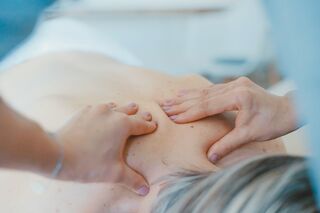
For over 40 years, I have practiced the integration of bodywork and psychotherapy as a clinician licensed in both disciplines. I have pioneered the integration of these methods at the Harvard Medical School Department of psychiatry in 1985 and have worked with over 60,000 clients. The application of these therapies is most effective when tailored to the needs of each individual and to their specific stage of recovery.
Massage and bodywork decrease depression and anxiety; they were used in children with PTSD following Hurricane Andrew (Field, Seligman, Scafidi, & Schanberg, 1996), in female survivors of sexual abuse (Field, et al., 1997; Price, 2005, 2007), and in dementia caregivers with a history of trauma (Korn et al., 2009). Several studies and metastudies have demonstrated efficacy for massage and bodywork for the treatment of fibromyalgia (Cao, Liu, & Lewith, 2010; Kalichman, 2010; Sunshine et al., 1996).
Massage is used extensively along with psychotherapy for the treatment of torture victims at rehabilitation centers around the world; it often comprises a special massage of the galea, a band of muscle around the head, for relief of the headaches common to nearly all torture victims (Bloch, 1988). Complementary forms of touch physiotherapy are practiced at rehabilitation centers throughout Europe with a focus on specific physical injuries; it includes body awareness methods that help the torture victim to accept his or her body again (Ortmann, Genefke, Jakobsen, & Lunde, 1987).
During the 1960s, the early pioneering work of biologist Bernard Grad, a student of the body-oriented psychoanalyst Wilhelm Reich, measured changes in the growth of plants and bacteria in response to the “laying on of hands.” Since then, numerous studies have measured functional alterations in brainwaves, heart rhythm, and hormone levels in response to direct touch or nonlocal “touch” or intention within healer and “healer.” Among the biofield, touch therapies are methods called therapeutic touch, Reiki, healing touch, and the light touch of polarity therapy. They all appear to reduce sympathetic activity (Cox & Hayes, 1999; Gehlhaart, 2000; Rowlands, 1984) by stimulating the vagal response. Biofield therapies also lead to a reduction in pain (Sansone & Schmitt, 2000), anxiety (Gagne & Toye, 1994), cancer-related fatigue (Roscoe, Matteson, Mustian, Padmanaban, & Morrow, 2005), quality of life (Metz, 1992), and depression (Field, 2000; Rowlands, 1984; Wardell & Engebretson, 2001). These therapies have, furthermore, been found to increase energy (Lee et al., 2001) and mood and improve sleep (Smith, Stallings, Mariner, & Burrall, 1999).
How does touch heal?
- Touch arouses, desensitizes, and transduces state-dependent memory; it also facilitates consciousness states associated with alpha, beta, theta, and delta brainwaves.
- Touch can induce trance and simultaneously provide the grounding rod to gain control over dissociative processes.
- Touch is anxiolytic and soporific; it also stimulates circulatory, lymphatic, and immune responses and regulates the primary respiratory mechanism (the cranial-sacral rhythm).
- Touch activates assorted neurohormonal responses, including the release of beta-endorphins, oxytocin, and serotonin; it improves cortisol levels and stimulates the endocannabinoid system.
- Touch provides a nonverbal form of biofeedback, allowing for the simultaneous retrieval of somatosensory memory, body sensations, articulation of associative feelings, and cognitive reframing.
- Touch changes body image and improves body concept, including the exploration of kinesthetic and proprioceptive boundaries as it reduces autonomic hyperactivity.
- Touch reduces lactic acid, thereby reducing the chemistry feedback loop of anxiety.
- Touch facilitates somatic empathy, a psychobiological attunement that is a prerequisite for attachment and bonding.
- Touch alters favorably the subtle human biofields that are the foundation of the healthy functioning of the human organism.
Therapeutic forms of massage and touch therapies like Polarity therapy, cranial-sacral therapies can be used alone or integrated into the psychotherapeutic model if the individual is trained and licensed to practice both therapies. It then is often called Body Oriented psychotherapy or somatic psychotherapy.

To learn more about therapeutic forms of massage and touch therapies, see my book Rhythms of Recovery: Trauma, Nature, and the Body.
References
Smith, M. C., Stallings, M. A., Mariner, S., & Burrall, M. (1999). Benefi ts of massage therapy for hospitalized patients: A descriptive and qualitative evaluation. Alternative Therapy for Health Medicine, 5 (4), 64–71.
Lee, M. S., Yang, K. H., Huh, H. J., Kim, H. W., Ryu, H., Lee, H. S., & Chung, H. T. (2001). Qi therapy as an intervention to reduce chronic pain and to enhance mood in elderly subjects: A pilot study. American Journal of Chinese Medicine, 29 (2), 237–245.
Field T. (2000). Touch therapy. London: Churchill Livingstone.
Metz, R. (1992). Application of magnetic and polarity principles to life energy systems. Santa Rosa, CA: Author.
Roscoe, J., Matteson, S., Mustian, K. M., Padmanaban, D., & Morrow, G. R. (2005). Treatment of radiotherapy-induced fatigue through a nonpharmacological approach. Integrated Cancer Therapy, 4 (1), 8–13.
Gagne, D., & Toye, R. (1994). The effects of therapeutic touch and relaxation therapy in reducing anxiety. Archives of Psychiatric Nursing, 8 (3), 184–189.
Sansone, P., & Schmitt, L. (2000). Providing tender touch massage to elderly nursing home residents: A demonstration project. German Nursing, 21 (6), 303–308.
Cox, C., & Hayes, J. (1999). Physiologic and psychodynamic responses to the administration of therapeutic touch in critical care. Complementary Therapies in Nursing and Midwifery, 5 (3), 87–92.
Ortmann, J., Genefke, I. K., Jakobsen, L., & Lunde, I. (1987). Rehabilitation of torture victims: An interdisciplinary treatment model. American Journal of Social Psychiatry, 7 (4), 161–167.
Bloch, I. (1988). Physiotherapy and the rehabilitation of torture victims. Clinical Management in Physical Therapy, 8 (3), 26–29.
Cao, H., Liu, J., & Lewith, G. T. (2010). Traditional Chinese medicine for the treatment of fibromyalgia: A systematic review of randomized controlled trials. Journal of Alternative and Complementary Medicine, 16(4), 397–409.
Korn, L., Logsdon, R. G., Polissar, N. L., Gomez-Beloz, A., Waters, T., & Rÿser, R. (2009). A randomized trial of a CAM therapy for stress reduction in American Indian and Alaskan Native family caregivers. Gerontologist, 49 (3), 368–377.
Field, T., Hernandez-Reif, M., Hart, S., Quintino, O., Drose, L., Field, T., Schanberg, S. (1997). Effects of sexual abuse are lessened by massage therapy. Journal of Bodywork and Movement Therapies, 1 (2), 65–69.
Field, T., Seligman, S., Scafi di, F., & Schanberg, S. (1996). Alleviating posttraumatic stress in children following Hurricane Andrew. Journal of Applied Developmental Psychology, 17 (1), 37–50.


